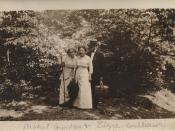During the 1900's, women had a vigorous thought to break through their confined lives at home. Since then the lives of woman has had a dramatic change. From the 1950's to 1990's I will describe how a simple housewife evolves through decades to become a woman at the workforce. They have been through a lot in the society to have gained such recognition and status.
Throughout the 1950's, Australia declared a principle that 'woman's place is in the home'. What this means is that a woman is to stay at home and be a good wife and mother. There have been many influences to promote this view without demur such as the family, school, church and some popular magazines. Well into the 1940s and 1950s, girls' school education taught them academic talents (e.g. sewing) to maintain the traditional 'female' skills for housekeeping as a wife. Employers around that time of century did not employ married women and expected them to have resigned if they plan to marry.
An event that occurred in 1961 was the introduction of the contraceptive pills which allowed women to control their birth. Many women wanted to feel economically secured and entered paid employment. Hence, the number of children per family decreased. In later years, 1969, the equal pay issue was raised to the federal government. Women declared to have a same wage as men did for the same work. However, this did not succeed.
The case of equal pay was looked at again in 1972, when Gough Whitlam reigned. He had made a promise to improve the social status of women and supported the recognition of the Equal Pay Rule. It was established on 15 December 1974 despite having different jobs, as long as they have the same worth then the rate of pay should also be the same.
Elsie was NSW's first women's refuge to be established. In 1975, Elsie provided accommodation and support for women with financial problems but were desperate to divorce their partners. In the same year, the Family Law Act 1975 was established. This principle of no-fault divorce allows women who suffer from abusive behaviours to feel guilt free, obtain property and custody of children.
It was finally illegal to discriminate on sex, pregnancy, marital status etc in 1977 when the Anti Discrimination Act 1977 was passed. Further on, this Act leads to the Anti-Discrimination Board which investigates and resolves complaints that were made. Sex Discrimination Act 1984 was passed by Prime Minister Bob Hawke in 1984. Any breaches made upon this act, the victim was able to claim compensation.
By the 1980's purchasing goods were very expensive and to meet this, households needed two incomes. Hence, this meant that women needed a paid job to help support the family income. Even though women began to work, men were not lenient to support this idea.
In 1986, the Affirmative Action Act was passed to improve the equality of opportunities for women within the workplace. Later in 1999, the Affirmative Action Act 1986 was being replaced with the Equal Opportunity for Women in the Workplace Act.
Beyond the 1990's, women at work had fewer chances of gaining opportunities as promotion because their work are still seen as less valued than the men's work. This was usually referred to as a 'glass ceiling' where they can see through to the upper management however cannot obtain their spot.
Today we can see how much distress women have gone through in the past 5 decades to have gained such power today. Their distress and unpleasant moments shall always be remembered.
Bibliography:womenshistory.about.com/od/lives20th/Womens_Lives_20th_Century.htmClassnotesHistory Textbook





